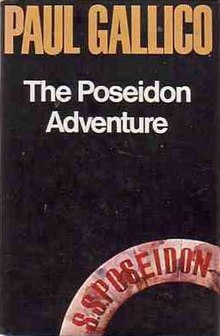Plot
Formerly the RMS Atlantis, the SS Poseidon is a luxury ocean liner from the golden age of travel, converted to a single-class, combination cargo-cruise liner. The ship is on her first North Atlantic crossing under new ownership, celebrated with a month-long Christmas voyage from Lisbon to African and South American ports. [1] On December 26, an undersea earthquake overturns the Poseidon. The ship capsizes as it falls into the void caused by the quake displacing millions of gallons of seawater.
Stuck within the upper deck dining room, preacher Reverend Frank "Buzz" Scott suggests his fellow survivors to move to the keel of the ship, where maybe they will have more chances of being rescued. Those who refuse to follow him stay behind.
The rest climb a Christmas tree with Scott to ascend into the galley area where they meet stewards and kitchen crew. The group debates whether to try to reach a propeller shaft at the stern, or to go to the bow. A steward fears the lockers that hold the anchor chains will have flooded, and suggests trying for the engine room.
After climbing two upside-down stairways, the group comes upon "Broadway", a wide service corridor that runs the length of the ship and connects to the engine room. The posse breaks for a while whilst looking for supplies. Young Robin Shelby ventures off to find the bathroom while Tony "The Beamer" Bates and his girlfriend Pamela find the liquor closet. When the ship's emergency lighting goes out, some crew members panic and stampede; they are trampled, or killed by falling over stairway openings or into a pit where a boiler tore through several decks. After the panic, Scott's group searches for Tony, Pamela, and Robin.
New York Police Detective Mike Rogo finds Tony passed out, intoxicated, and Pamela refuses to leave him. While searching for Robin, his older sister Susan is raped by Herbert, a young, terrified crew member. Susan talks with Herbert, who is remorseful and ashamed, and grows to like him. Realizing the consequences of his actions, Herbert panics, runs off and falls to his doom. Susan rejoins the group and tells them nothing of what has happened.
After an intense search, they make the decision to move on without Robin. His mother, Jane, breaks down and vents her long-held disgust and hatred for her husband. The Reverend, having found a Turkish oiler, guides the other survivors to the stern. They find a corridor to the engine room, which is completely submerged. Belle Rosen, a former W.S.A. champion, swims through the corridor and finds the passage to get them to the other side. Upon their arrival, they find the engine room.
They take time to rest and save the batteries on their recently acquired flashlights. In the darkness, Linda Rogo makes a move on the Reverend. After their rest, they see the way out—five decks up, on top of a fractured steel wall. During the difficult climb, Linda rebels and attempts to find her own way. She chooses an unstable route and falls to her death, impaled on a piece of steel. An explosion rocks the ship, and Reverend Scott, enraged, denounces God, offers himself as a sacrifice, and commits suicide. Mary Kinsale, an English spinster, screams in grief and claims they were to be married. Her fellow survivors do not know what to make of this revelation.
Mr. Martin takes charge of the group, who make their way into a propeller shaft where the steel hull is at its thinnest. The oxygen supply begins to give out, but after much waiting, they are found. Belle Rosen has a heart attack and dies before the rescue team can reach her. The team cuts through, and the group climb out of the upturned hull. Manny Rosen, however, refuses to leave without Belle's remains, which are lifted out after the others have left. Once outside, the survivors see another, much larger group of survivors being removed from the bow of the ship. Most are still in their dinner clothes, in contrast to Scott's group, who are mostly in underclothing and streaked with oil.
En route to the rescue ships in lifeboats, they see Tony and Pamela, who have survived after all. Sailors from a small German tramper try to put a salvage line on the Poseidon. Mike curses them because of his World War II experiences and laughs when their efforts fail. The group goes their separate ways—Mary Kinsale and Nonnie on a ship back to England; Mike, Manny, Hubie Muller back to New York, Martin back to Chicago, Dick, Jane and Susan back to Michigan; and the Turk back to Turkey. Aboard the American ship, they watch the Poseidon sink. Jane, giving up hope, silently grieves the loss of her son.
Susan, meanwhile, dreams of going to Hull in England to visit Herbert's parents. She hopes to be pregnant with his child so he would have a legacy.
